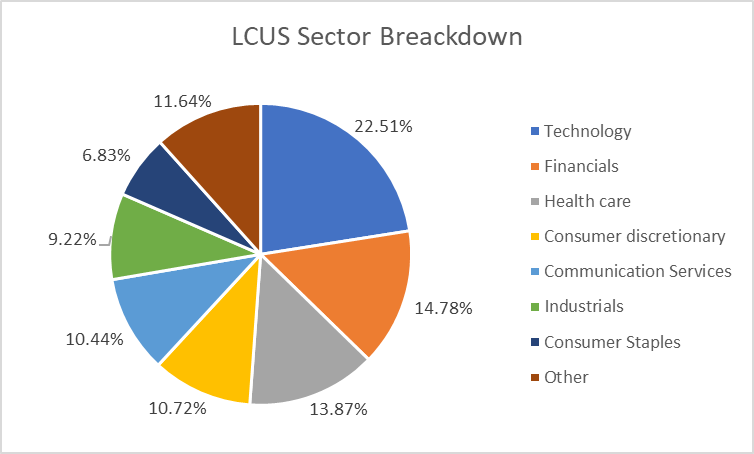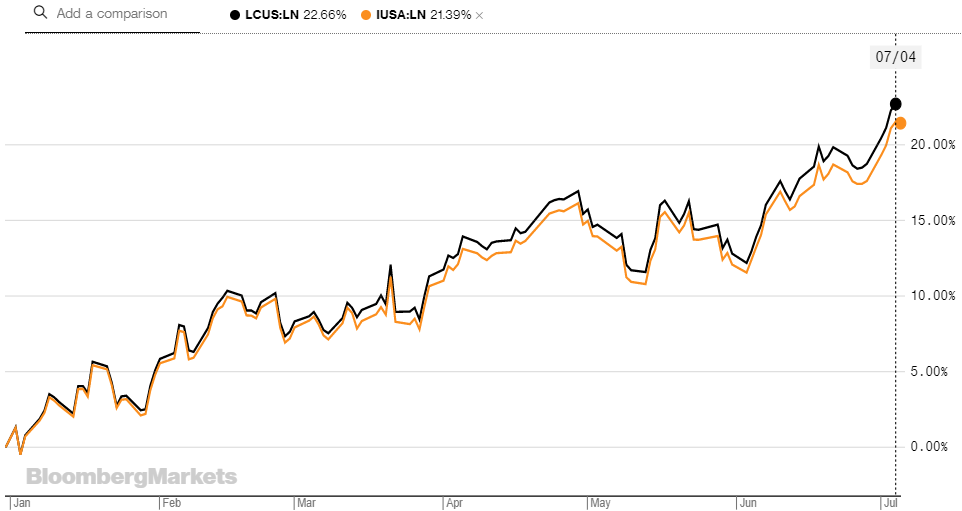The US is home to some of the biggest and fastest growing companies in the world which any investor should consider holding in their portfolios. The largest ETF in the world by assets is the US-based SPDR S&P 500 ETF Trust (SPY) which has over $270bn assets under management and has an expense ratio of 0.095%.
For US equity ETF buyers on the other side of the Atlantic, there are numerous products available depending on the investor’s preference on fees, performance and liquidity. Two popular products in Europe include the Lyxor Core Morningstar US UCITS ETF (LCUS) and the iShares Core S&P 500 UCITS ETF (IUSA).
We will be taking a look at the key differences between LCUS and IUSA with features worth considering when adjusting exposures to the region's asset class.
ETFLyxor Core Morningstar US UCITS ETF (LCUS)iShares Core S&P 500 UCITS ETF (IUSA)AUM$56m$3.7bnBenchmarkMorningstar US Large-Mid Cap NR IndexS&P 500 IndexExpense ratio0.04%0.07%Inception Date22/03/201829/03/2002
Investment strategy
Although they track different indices, LCUS and IUSA have very similar investment strategies. Both ETFs’ top holdings include Microsoft, Apple, Amazon and Facebook, the largest US-based companies in terms of market cap. The only differences being the weighting of the holdings as the Morningstar US Large-Mid Cap Index has more components.
The S&P 500 is comprised of the 500 largest companies in the US by market cap whereas Morningstar US Large-Mid Cap Index also includes mid-cap companies, offering exposure to 789 components.


The sector breakdown of the ETFs vary, but only slightly. Technology is the largest exposure for both products, however 22.5% of LCUS is comprised of technology stocks whereas IUSA is only 19.3%. Despite LCUS having nearly 50% more holdings than IUSA, the sector breakdowns do not vary much more than 2%.
Cost and tradability
LCUS comes with a TER of 0.04%, the cheapest in Europe and even rivals ETF issuers in the US with the exception of a couple of 3bps products and zero-fee ETFs which are only “free” for the first two years of their launch. Nonetheless, IUSA comes with a competitive 0.07% which is even cheaper than SPY, the world’s largest ETF which tracks the same index and charges 0.095%.
Elsewhere, the average 52-week premium for both LCUS and IUSA are even closer with 0.02% and 0.03%, respectively. However, both products are trading at a discount, meaning current holders would have likely bought slightly high and would be selling low. More so for LCUS buyers as the ETF is currently trading at a discount of 46bps whereas IUSA is trading at a discount of 35bps.
Performance
LCUS is only 15 months old so performance comparison between the two ETFs is limited. However, Lyxor’s products just edges it for the year so far, producing year-to-date returns of 22.7% with iShares’ ETF offering 21.4%.
Looking over the last 12-months, performance is identical despite IUSA outperforming for long periods in the later end of 2018 when volatility was high.
A noteworthy point is the performance of the two ETFs during the stormy Q4 which impacted the global equity market. IUSA fell 21.7% over the period however, as a result of LCUS’s larger portfolio, the ETF only fell 16.1%. LCUS not only offers the better returns but also reduces losses during volatile markets.

LCUS (Black) & IUSA (Yellow) YTD returns - Source: Bloomberg
Dividends
IUSA has the greater dividend offering of 1.49% for its last payment reported. As a result of its inclusion of mid-cap stocks, LCUS's last dividend payment was 1.27%, meaning its regular payment to investors is 22bps less than its competitor. Despite being 3bps cheaper, its potential to be sold at a greater discount of 11bps and smaller dividend payment quickly erases this benefit.
Domicile
Lyxor's LCUS is domiciled in Luxembourg and iShares' IUSA is based in Ireland. US equity funds domiciled in Ireland benefit from a tax treaty that is in place between the two countries, according to James McManus, investment manager and head of ETF research at Nutmeg. Therefore tax applied to dividends is just 15% rather than the standard rate of 30% which can significantly effect the fund's performance compared to its benchmark.
Benchmarks usually assume the 30% tax rate and means Irish domiciled funds will tend to outperform post-fees. McManus says IUSA has beaten the S&P 500 Net Total Return Index by 7bps after fees which alone nullifies the ETF's expense ratio.
Conclusion
LCUS and IUSA might have only minor differences but could be influential depending on the investor’s strategies and preference. If you are a short-term investor and hoping to get out of the equity market when volatility inevitably returns, the more liquid IUSA will be the better option with its larger AUM.
The S&P 500 has also reached a new all-time high for the ninth time this year already, totalling this decade’s personal bests to 216 with another six months to go. That means there has been 216 times for potential returns.
If you are looking long-term investment, then LCUS is probably more suited. The ETF has a fractionally lower average premium, as well as the significantly low expense ratio of 0.04% which becomes more noticeable with larger trades. LCUS also offers greater diversity holding over 750 stocks meaning losses are reduced and has produced greater returns this year so far during a bull run.






